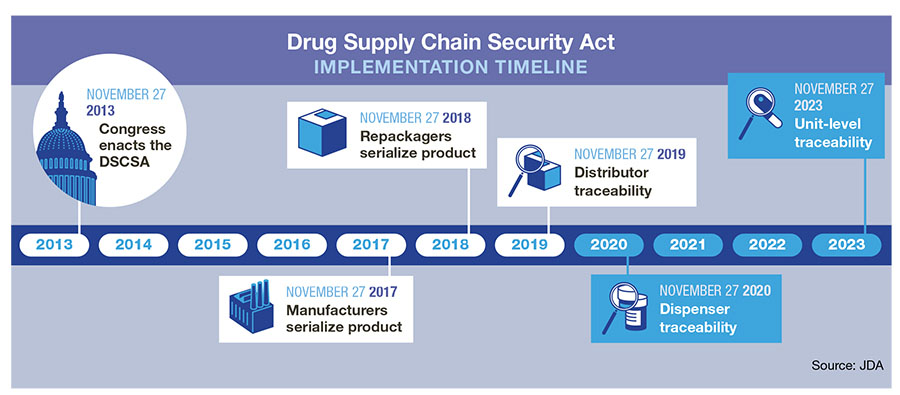Pharma races toward its future
Whether inside the four walls or between locations, the pharma supply chain is becoming increasingly complicated. The reasons range from new Federal regulations to increasing demand for delivering more drugs faster than ever before. This is a game changer.
Talk to the people in the know about trends in pharma these days, and it becomes clear pretty quickly that things are in flux. And we’re not talking a tweak here, a tweak there, either.
These shifts include:
- The spiraling expiration of patents and the rise of generics,
- The ascendancy of drugs that require precise cold chain control, and
- Federal regulations requiring iron-clad track and trace of drugs at the unit level.
Each is a disruptor of the pharma supply chain in its own rite. Taken together, they challenge the industry mightily, and it’s not always possible to take on all challenges at the same time.
For instance, one expert says pharma supply chains are almost focused on creating track-and-trace systems that meet the federal regulations that go into full force in 2023 (see timeline, p. 55). While others say regulations are certainly dominant, but efficiencies of handling drugs and processing orders is not being overlooked by any means. Interestingly enough, those are not contradictory statements.
As it turns out, the two are intertwined. While one (regulations or efficiencies) may be dominant on a given day, the other is part of developing the right solution. It’s a complex web. Bar codes, software and blockchain all figure prominently.
So does automation. Beyond regulations, demands from customers at each stage of the pharma supply chain are continuing to increase, explains Michael Pietras, executive sales manager at SSI Schaefer.
“At all stages, the customer wants shorter shipping times even as distribution points increase along with SKU counts,” Pietras says. While he wouldn’t call the situation manic, Pietras will say that the demands are moving beyond what can be done in conventional manual order fulfillment environments. “The move is away from manual person-to-goods fulfillment to automated goods-to-person,” he adds.
There’s also the Amazon effect with the e-commerce giant’s purchase of PillPack, explains Dan Gilmore, chief marketing officer at Softeon. He explains that, in many cases, supply chain efficiencies have not traditionally been a top-level concern for pharma. However, that is likely to change. After all, PillPack’s tag line is: “Your medication delivered.”
At the same time, pharma growth is strong, says El Marie Hugo, JDA’s senior director of industry strategy. She says overall compound annual growth of the industry is estimated to be between 12% and 14%, “just as pharma is becoming a much more complicated supply chain.”
Sorting it out
Probably the best place to start is regulations. They have had a tortured path to this point and the going is not about to get any easier anytime soon.

It all started with California and Florida establishing their own state track-and-trace regulations almost a decade ago, explains Adam Kline, senior director of product management at Manhattan Associates. However, it became apparent early on that different regulations state-to-state would be debilitating for the industry.
Amid a barrage of lobbying, the federal regulation known as the Drug Supply Chain Security Act (DSCSA) was passed Nov. 27, 2013. As the timeline shows, key milestones include serialized product from manufacturers, repackagers, wholesale distributors and dispensers, all key points in the pharma supply chain. The end point is unit-level traceability, also known as the chain of custody, across the entire supply chain by Nov. 27, 2023.
That said, those federal deadlines are still in flux. In October, the FDA delayed this year’s Nov. 27 deadline requiring wholesale distributors to verify a product identifier. That was pushed out until exactly one year later, according to the Federal Register on Sept. 24, 2019. Obviously, making all this work is real challenge.
That was certainly evident speaking with DMLogic’s Matt Deep, vice president product development. He described all the points at which data about a drug shipment at the unit level could be compromised.
It starts with all the cases on a pallet load and goes all the way down to the individual container for each unit-level dose. Then, there’s the matter of breaking down the supply chain into what is received by the next node, how it’s tracked at that node and then when it is shipped to the next node. Don’t forget about drugs that are returned, accounting for a significant percentage of all volume. “There are just so many opportunities to compromise tracking and tracing of a drug before it gets to its final destination,” says Deep.
Fortunately, the case for making this work goes well beyond the regulations themselves. “This is all about patient safety,” explains Hugo of JDA.
Enter technology
At first, the answer appeared to be RFID. Tag everything, build a pallet load and read all tags at the same time with 100% accuracy. However, RFID was not up to the job.
Today, bar codes are the focus of data collection for the DSCSA. Traditional one-dimensional bar codes are giving way to two-dimensional bar codes. This shift bypasses the need to access a central database to know what is in a shipment with traditional bar codes. Instead, 2D bar codes are a traveling database in and of themselves, providing key data on the spot.
Kline of Manhattan says regulations require that half of all shipments from manufacturers use 2D bar codes by 2019. And by 2023, the regulations require full adoption of 2D codes across the entire pharma supply chain.
Meanwhile, high-speed automated scanners are on conveyor lines and in automated order fulfillment systems, manual data capture still dominates. Quite simply, so much of pharma order fulfillment is still manual person-to-goods operations, explains Mark Wheeler, director of supply chain solutions for Zebra.
The idea, he says, is to outfit people with wearable scanners that speed the scanning process and flow of goods. For instance, Zebra is replacing its standard two-finger ring scanner with a single-finger 2D ring scanner. Bluetooth capabilities speed the movement of data from the point of collection to a data management platform, says Wheeler. “Essentially, those scanners make it economical to capture extended item data at every step of the process,” he adds.
According to Pietras of SSI Schaefer, a shift is underway from pick-to-light, voice and RF systems to collect data in pharma order fulfillment. He says the alternative is automation such as automated storage and retrieval systems (AS/RS) and A-frame item dispensers.
“More aggressive order windows are the trend, yet operations will have to ensure order integrity of the order,” he says. “The answer is often to automate order fulfillment as much as possible, including data capture. The target is 100% order verification right down to the unit-dose level,” says Pietras.
Tecsys, says product strategy manager Jean-Philippe Racette, is primarily focused on the pharmacy supply chain, especially for hospitals, which also must comply with the DSCSA. While track-and-trace capabilities at the unit-dose level benefit from bar codes, so do other activities.
Racette says these include the ability to better manage drug shortages (something that is making its own headlines recently) with demand visibility and distribution planning. It also makes centralized distribution more manageable, reducing unnecessary inventory as well as expired inventory. And centralized distribution is less common now than individual hospital pharmacies doing their own buying and inventory management.
“Hospitals just don’t have access to much of this data now. And while patient safety is paramount, track-and-trace of drugs will have a broader impact on the efficiencies and cost effectiveness of the pharma supply chain,” says Racette.
Building the network
Meanwhile, various points in the pharma supply chain, especially distributors, have “a reasonably strong interest in warehouse management systems (WMS),” says Gilmore of Softeon. He continues to say that many are still running on spreadsheets, but that is changing.
“They’re interested in WMS not for order picking but for traditional inventory management and replenishment capabilities,” continues Gilmore.
“WMS mitigates so many chain-of-custody issues within the four walls,” explains Kline of Manhattan. “The software not only collects and manages data but expedites data handling to improve the flow of inventory and orders,” he adds.
“At the same time,” says Gilmore, “distributed order management (DOM) is gaining interest. From hospitals to distributors and manufacturers, the pharma supply chain needs to be able to look across the entire network to determine where is the place to source today what they need today. They have the same sorts of basic order sourcing challenges that omni-channel retailers do,” Gilmore adds.
Hugo of JDA sees much the same trends, emphasizing the need for improved forward planning. “This is a huge shift for an industry that has not been nearly as focused on forward planning as it will be in the future,” she adds. Drivers here include the shift to new drugs, often called personalized medicine, that will proliferate SKUs at the same time as product life cycles shorten.
One of the more ambitious projects in the pharma supply chain is the MediLedger Project. “Using blockchain, MediLedger provides secure, trusted product data and verification at all nodes in the pharma supply chain,” explains Susanne Somerville. She is CEO of Chronicled, a technology company that writes software for blockchain and started the MediLedger Project.
She continues to say, “Blockchain enables the industry to operate safely in a shared network that will enable improved communication of transactions and business rule enforcement.”
Even though the FDA has pushed out the date for wholesale distributors to verify a product identifier last month, MediLedger went ahead with its plans to do that using blockchain now, says Somerville. She says it will:
- keep an immutable record of transactions and data,
- enforce cross-industry business rules without compromising individual company data,
- protect each participant’s business intelligence, and
- connect trading partners across the pharma supply chain.
All of that said, pharma is certainly a hot spot in the supply chain today. And, by all indications, that’s going to be case for the foreseeable future.
Companies mentioned in this article
Chronicled
DMLogic
JDA
Manhattan Associates
Softeon
SSI Schaefer
Tecsys
Zebra

Article Topics
Inventory & Picking News & Resources
Manhattan Associates selects TeamViewer as partner for warehouse vision picking Consultant and industry leader John M. Hill passes on at age 86 Siemens, Universal Robots, and Zivid partner to unveil smart robotic picking solution AI-based inventory monitoring solution provider Gather AI raises $17 million NRF 2024 retail sales forecast calls for growth Swisslog gives live demonstration of ItemPiQ latest evolution Cimcorp automates fresh food distribution with flexible storage, order picking solutions More Inventory & PickingLatest in Materials Handling
Geek+ and System Teknik deploy PopPick solution for pharmacy group Med24.dk Beckhoff USA opens new office in Austin, Texas Manhattan Associates selects TeamViewer as partner for warehouse vision picking ASME Foundation wins grant for technical workforce development The (Not So) Secret Weapons: How Key Cabinets and Asset Management Lockers Are Changing Supply Chain Operations MODEX C-Suite Interview with Harold Vanasse: The perfect blend of automation and sustainability Consultant and industry leader John M. Hill passes on at age 86 More Materials HandlingSubscribe to Materials Handling Magazine

Find out what the world's most innovative companies are doing to improve productivity in their plants and distribution centers.
Start your FREE subscription today.
April 2024 Modern Materials Handling

Latest Resources












